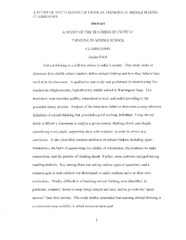| dc.description.abstract | Critical thinking is a skill few utilize in today’s society. This study seeks to determine how middle school teachers define critical thinking and how they believe they teach it in the classroom. A qualitative case study was performed by interviewing five teachers in a high-poverty, high-diversity middle school in Washington State. The interviews were recorded audibly, transcribed to text, and coded according to the grounded theory process. Analysis of the interviews failed to determine a comprehensive definition of critical thinking, but provided a good working definition: Using the top levels of Bloom ’s Taxonomy to analyze a given context, thinking slowly and deeply, considering every angle, supporting ideas with evidence, in order to arrive at a conclusion. It also identified common attributes of critical thinkers including openmindedness, the habit of questioning the validity of information, the tendency to make connections, and the practice of thinking ahead. Further, some patterns emerged among teaching methods. Key among them was asking various types of questions, and a common goal in each method was determined: to make students arrive at their own conclusions. Finally, difficulties of teaching critical thinking were identified, in particular, students’ desire to keep things simple and easy, and to go with the “quick answer,” their first instinct. The study further concluded that teaching critical thinking is a community responsibility in which everyone takes part. | en |


 Maintained by the Northwest University Library
Maintained by the Northwest University Library